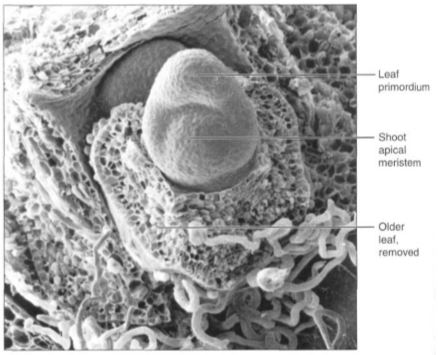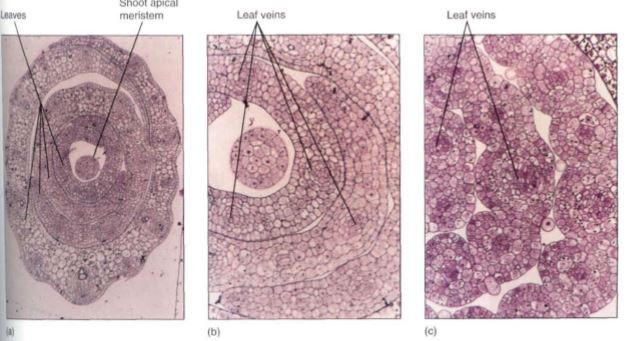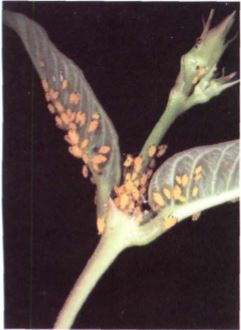


 النبات
النبات
 الحيوان
الحيوان
 الأحياء المجهرية
الأحياء المجهرية
 علم الأمراض
علم الأمراض
 التقانة الإحيائية
التقانة الإحيائية
 التقنية الحيوية المكروبية
التقنية الحيوية المكروبية
 التقنية الحياتية النانوية
التقنية الحياتية النانوية
 علم الأجنة
علم الأجنة
 الأحياء الجزيئي
الأحياء الجزيئي
 علم وظائف الأعضاء
علم وظائف الأعضاء
 الغدد
الغدد
 المضادات الحيوية
المضادات الحيوية|
Read More
Date: 13-11-2016
Date: 21-11-2016
Date: 29-10-2015
|
Initiation and Development of Leaves
DICOTS
Leaves are produced only through the activity of a shoot apical meristem. At the base of the meristem, cells just interior to the protoderm grow outward, forming a protrusion known as a leaf primordium (6.27) that extends upward as a narrow cone, growing so rapidly that it becomes taller than the shoot apical meristem. During this stage the primordium consists of leaf protoderm and leaf ground meristem, and all cells are meristematic, with dense cytoplasm and small vacuoles. A strand of cells in the center differentiates into provascular tissue and then into primary xylem and phloem, forming a connection with the young bundles in the stem.

FIGURE 1: The shoot apical meristem of grape (Vitis riparia) can be seen in three dimensions in this scanning electron micrograph. Notice the large leaf primordium above it; another leaf primordium below has been removed; the phyllotaxy is established at the very apex (X 200).
As the leaf primordium grows upward, it increases in thickness, establishing the bulk of the midrib. A row of cells on either edge of the primordium grows outward, initiating the formation of the lamina (Fig. 2). As a result of their activity, the young leaf consists of a midrib and two small, thin wings. All cells in the wings are meristematic, and their division and expansion enlarge the lamina rapidly (Fig. 3). In a compound leaf, two rows of loci initiate leaflets, which then grow like simple leaves. During lamina expansion, stomata, trichomes, and vascular bundles differentiate, and the petiole becomes distinct from the midrib.

FIGURE 2: (a) The uppermost leaf primordium is the oldest, and its sides have begun growing out as the lamina of a simple leaf of Vitis (X 270). (Courtesy of C. R. Lacroix and U. Posluszny) (b) In this compound leaf, rather than forming a lamina, six leaflet primordia have been established (X 150).

FIGURE 3: (a) A low-magnification transverse section through young, developing leaves of the grass Panicum effusum. The central round structure is a section of the shoot apical meristem, and the leaves encircle it (grasses have sheathing leaf bases) (X 200). (b) At higher magnification, you can see that all cells in the leaves are still small and cytoplasmic, and the central vacuoles are small. At this stage, all leaf cells are still undergoing mitosis and cytokinesis. The leaf veins are starting to differentiate (X 500). (c) At an older stage, the leaf veins are more distinct. The first protoxylem tracheary elements are mature in some veins, but most cells that will differentiate into tracheary elements are still enlarging (X 500).
In many perennial plants, leaves are initiated in the summer or autumn before they mature. Once they reach the developmental state just described, they become dormant, part of a resting terminal or axillary bud. During the next growth period, usually the following spring, the bud opens and the primordial leaves expand rapidly as each cell absorbs water into its vacuole and swells (Fig. 4). Little or no mitosis or cell division may occur—only maturation, especially the synthesis of chlorophyll, cutin, and wax. As the leaves expand, the immature, exposed epidermis is very vulnerable, especially to insects (Fig. 5). In many species of annual plants, the process is similar, with the embryo in the seed acting like the buds of perennial plants. They initiate leaves before the seed becomes dormant and dry, and those leaves absorb water and expand rapidly during germination.

FIGURE 4:Terminal bud of beech (Fagus grandifolia) beginning to expand in the spring. The brownish bud scales are being pushed back and will soon abscise as the new foliage leaves swell. The bud's apical meristem may be initiating new leaf primordia that will expand a little later in the spring, but in some species it may be producing flowers at this time instead.

FIGURE 5: Aphids and other sucking insects typically attack young leaves and stems that have not yet developed any protective sclerenchyma around the vascular bundles.
MONOCOTS
Monocot leaves, like those of dicots, are initiated by the expansion of some shoot apical meristem cells to form a leaf primordium (Fig. 6). Apical meristem cells adjacent to the primordium grow upward along with it, becoming part of the primordium and giving it a hoodlike shape. More apical meristem cells become involved until the primordium is a cylinder that completely or almost completely encircles the shoot apical meristem. As the shoot apex elongates and forms new stem and leaf tissue, the tubular portion of the leaf primordium continues to surround it as the sheathing leaf base. The original conical leaf primordium, now located on one side of the top of the tube, gives rise to the lamina.
In some monocots, the lamina becomes broad and expanded like a dicot lamina. But grasses, lilies, and many others have linear, strap-shaped leaves that grow continuously, having no predetermined size. Their lamina grows by a meristem located at its base where it attaches to the sheathing leaf base. The meristematic cells remain active mitotically, producing new cells that extend the leaf. Even if a grazing animal, a range fire, or a lawnmower destroys much of the leaf, the meristem can form a new lamina. This type of regeneration is not possible in dicot leaves.

FIGURE 6.32 In a monocot, after the center of the leaf primordium has been initiated (a), neighboring regions of the shoot apical meristem become active and contribute to the primordium. This results in a leaf base that encircles the stem, forming a sheath around it (b). (a, X 150; b, X 120) .
The constant basal expansion means that the protoxylem and protophloem are constantly being stretched and disrupted in the basal meristem, but new vessel elements and sieve tube members differentiate rapidly enough that conduction is never interrupted. Just above the basal meristem is a region where tissues differentiate: More primary xylem and phloem are initiated, as are stomata and other features. Higher above the basal meristem, tissues are mature; differentiation is similar to that for stems but is oriented upside down in monocot leaves.



|
|
|
|
التوتر والسرطان.. علماء يحذرون من "صلة خطيرة"
|
|
|
|
|
|
|
مرآة السيارة: مدى دقة عكسها للصورة الصحيحة
|
|
|
|
|
|
|
نحو شراكة وطنية متكاملة.. الأمين العام للعتبة الحسينية يبحث مع وكيل وزارة الخارجية آفاق التعاون المؤسسي
|
|
|